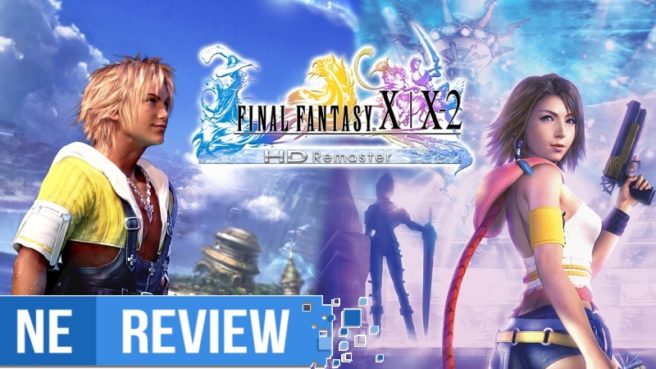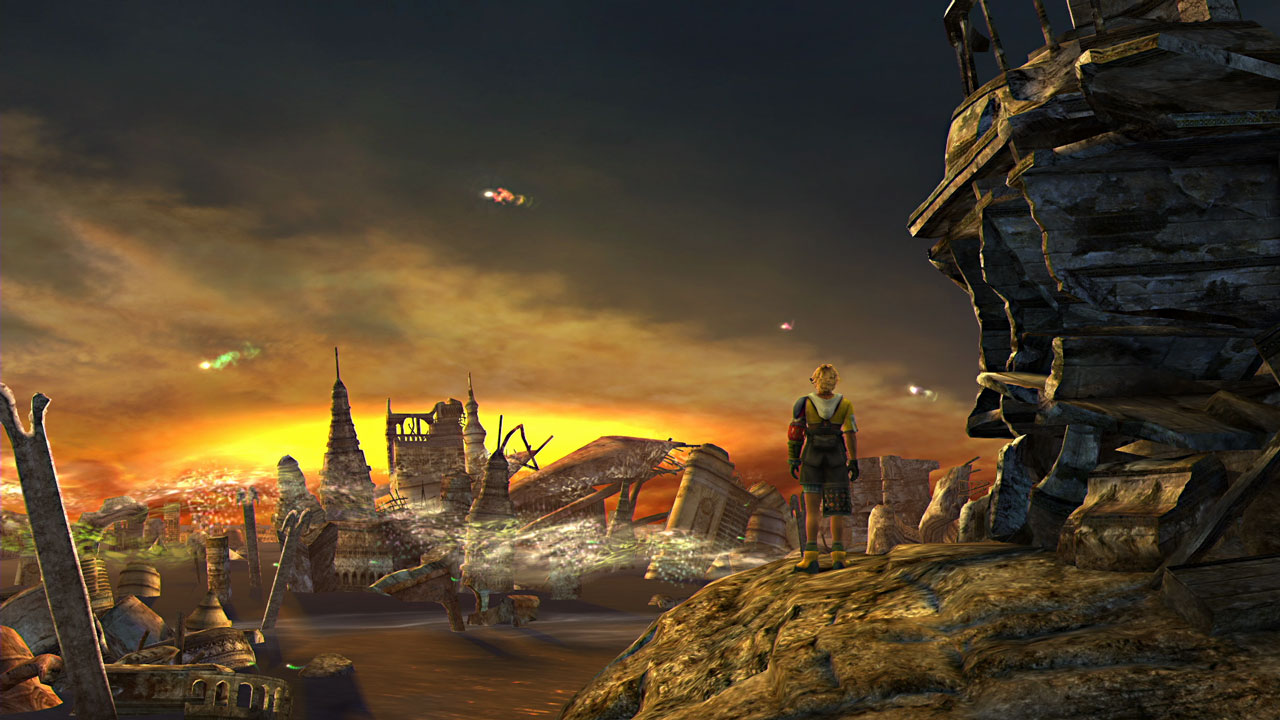[Review] Final Fantasy X / X-2 HD Remaster
Posted on April 28, 2019 by Campbell(@CampbellSGill) in Reviews, Switch
System: Switch
Release date: April 23, 2019
Developer: Square Enix / Virtuos
Publisher: Square Enix
It’s just another ordinary day: Hell has frozen over, pigs are soaring across the skies, and you’re playing Final Fantasy X on a Nintendo console. What was once thought impossible has become a delightful role playing reality. The series infamous for its break with Nintendo has come back home with plenty of classic games in tow, and this remarkable trend continues with the release of Final Fantasy X and its direct sequel on Switch. So many years after these games defined a generation of RPGs, they continue to hold up in fine form on Nintendo’s newest system, retaining every bit of their strategic and storytelling brilliance with a few modern enhancements thrown in to sweeten the deal.
Final Fantasy X starts out with what has to be one of gaming’s most simultaneously effective and puzzling beginning sequences. The opening cutscene presents a few survivors in a world that has been struck with complete desolation – destroyed buildings, burnt fields, and lifeless bodies abound. It soon takes us back to the events before this catastrophe, showing a vibrant futuristic city called Zanarkand, where a young athlete named Tidus is on his way to a championship game. Just as the festivities begin, a monstrous whale-like creature known as Sin attacks, obliterating the city and, in the process, flinging Tidus a thousand years into the future, to the world of Spira. Tidus is left stranded in this distant future, where he soon comes into contact with the various religious and racial groups of Spira, eventually leading him to meet the summoner Yuna, a young priest granted the rare power to destroy Sin. Before long, Tidus is roped into protecting Yuna as she and her other guardians travel to temples throughout Spira, preparing for the final showdown with Sin.
This is merely scratching the surface of Final Fantasy X’s deep narrative. So many different threads are woven into its intricate storytelling – strife between racial groups, religious devotion vs. worldly practicality, the meaning of love and duty, and the conflict of man vs. machine are just a handful of the many themes discussed throughout the game’s story. None of these ideas are presented in a heavy-handed manner – rather, they all arise subtly and naturally throughout the story, told with delicacy and intelligence. Better yet, none of these ideas are presented simply because they’re the topics that “should” be addressed in a serious Japanese RPG. Instead, they all appear because they’re important in the world of Spira.
The world building itself is perhaps Final Fantasy X’s greatest strength. With its many locales, languages, cultures, and religions, Spira is built up as a truly living, breathing world. It effortlessly presents itself so well. None of this depth is conveyed via intrusive info-dumping, as many RPGs are wont to do; instead, Spira is made more and more real with every conflict and conversation that you experience on your journey. The exposition is just clear enough to give players a good idea of the world without smacking them over the head with blunt exposition. There’s no big warning signs shouting “Yevon is basically the God of this world, idiot.” The old adage of “show, don’t tell” certainly rings true, as the game shows its world in all its joys, brokenness, conflict, rituals, and routines in plain sight just as they are.
Of course, the world building and storytelling don’t mean much if there isn’t a solid gameplay loop to back it up. Thankfully, Final Fantasy X excels in this department as well, providing a traditional battle experience punctuated with a handful of significant changes. It’s an old-fashioned turn-based affair that keeps many of the best things about its forerunners. One of the best parts of classic Final Fantasy battles was how it all made sense: only ranged attacks will reach airborne enemies, fire spells will instantly melt ice enemies, only heavy swords can break through a lizard enemy’s tough shell, and so on. All this beautiful simplicity displays itself in full force in Final Fantasy X, creating an elegantly simple battle system. This logic is supported by one of the game’s handful of combat innovations: for the first time in series history, you can swap out any of your party members during a battle. This is an absolute godsend for strategizing, since you don’t have to stress about who you have to take with you and who to leave behind at the party base. If a flying enemy appears and your current party is completely composed of warriors, there’s no need to worry; just switch one of them out with Wakka and use his signature blitzball attack to strike it down.
Another innovation in Final Fantasy X’s combat is how it handles turn orders. Unlike many of the previous entries that came before it, Final Fantasy X ditches the active time battle system, opting instead for a strictly turn-based affair. There are no filling meters or time constraints to worry about (save that for the sequel!) since turns follow each other in a fixed sequence and battles pause whenever it’s your party’s turn to fight, giving you ample time to strategize. Despite these changes, Final Fantasy X is still a traditional game at heart, as is most vividly showcased with its random encounters, which can sometimes feel like they pop up just a bit too frequently. Due to many of the improvements previously mentioned, these fights generally fly by at a brisk pace and rarely interrupt the general flow of gameplay. Final Fantasy X’s fights do everything right: they’re balanced, swift, and thrilling.
Whenever you finish a battle and see your party’s levels increase, you might expect their stats to automatically rise along with them. However, Final Fantasy X mixes up its progression system. Rather than each party member’s stats rising with every level, you are given complete control of how they improve by using the game’s innovative Sphere Grid. With each level, a character is able to move over more spheres on the grid, each of which contains a status buff or ability to learn. For example, if your character is currently at level 2, they can progress across two spaces on the grid. In order to learn abilities, specified spheres will be needed – you’ll need power spheres for health and attack upgrades, mana spheres for magic buffs, etc. Each character’s path on the grid starts out fairly linear, but as you gain experience, you’ll be presented with choices over which direction you want to take them; you’ll have to decide whether you want to focus on making your character into a mage, a warrior, a support healer, and so on. This simple addition manages to give the player a remarkable level of control over the end result of each character while never feeling overwhelming. It may sound complex on paper, but in practice, the system comes across intuitively.
Of course, no RPG is complete without loads of side content, and Final Fantasy X is appropriately packed with minigames and side modes that help spice up the moment-to-moment gameplay. The most significant of these has to be Spira’s favorite pastime, blitzball. Imagine an underwater mixture of football and basketball with a healthy dose of role playing strategy strewn throughout, and you’ll have a decent idea of the sport. Blitzball comes off at first like an unwieldy blend of typical sport simulator gameplay meshed with menu-based RPG mechanics, littered with unique stats, conditions, and abilities that need to be understood to succeed. Give it the time it needs, however, and it’s easy for it to get its hooks in you. It’s effectively an entire game in its own right, since you can spend hours upon hours optimizing and upgrading your team and taking on championship games. It’s an appreciated diversion from the main game, but for those who don’t want to invest the time to come to grips with the myriad of systems at play in blitzball, you’re allowed to basically ignore the game entirely outside of a handful of story moments.
There is no denying that Final Fantasy X is a notoriously linear game. You are rarely given the opportunity to revisit previous areas or go off the beaten path – in fact, many field areas are essentially beautified hallways. Even though linearity has become something of a dirty word in gaming as of late, Final Fantasy X uses it to its full advantage. By knowing exactly how the player will progress, the game knows how to pace itself and can focus on shuttling the player between an impressive variety of memorable moments. From tense combat sequences to gripping story moments, Zelda-esque puzzle-filled dungeons to breaks of open exploration in fields and towns, the game’s linear structure allows it to craft an experience that is consistently engaging and exciting throughout its roughly fifty-hour main story.


